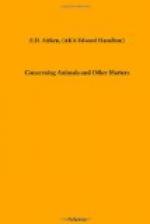There has been another attempt to misuse and pervert this part of the face which I scarcely dare to touch upon, for it is so utterly fantastic and mystical that I fear the charge of heresy if I give words to my thoughts. It occurs among bats, a tribe of obscure creatures about which common knowledge amounts to this, that they fly about after sunset, are uncanny, and fond of getting entangled in the hair of ladies, and should be killed. But there are certain families of bats, named horseshoe bats, leaf-nosed bats and vampires about which common knowledge is nil, and the knowledge possessed by naturalists very little, so I will tell what I know of them. They are larger than common bats, their wings are broad, soft and silent, like those of the owl, they sleep in caves, tombs and ruins, they do not flutter in the open air, but swiftly traverse gloomy avenues and shady glades, their prey is not gnats and midges, but the “droning beetle,” the death’s head moth, the cockchafer, croaking frogs, sleeping birds and human blood. The books will tell you that these bats are distinguished by “complicated nasal appendages consisting of foliaceous skin processes around the nostrils,” which is quite true and utterly futile. It may do for a dried skin or a specimen in spirits of wine. I have had the foul fiend in a cage and looked him in the face. His whole countenance, from lips to brow and from cheek to cheek, is covered and hidden by a hideous design of
Spells and signs,
Symbolic letters, circles, lines,
sculptured in living, quivering skin. It is a sight to make the flesh creep. The books suggest that these foliaceous appendages are the organs of some special sense akin to touch. Futile again! There are things in Nature still which prompt the naturalist who has not atrophied his inner eye and starved his imagination to cry out:
Science ...
Why preyest thou thus upon the poet’s
heart,
Vulture, whose wings are dull realities?
Supposing there should be in the unseen universe an evil spirit, an imp of malice and mischief, not Milton’s Satan, but the Deil of Burns:
Whyles ranging, like a roaring
lion,
For prey, a’ holes an’
corners tryin;
Whyles on the strong-winged tempest flyin,
Tirlin the kirks;
Whyles in the human bosom pryin,




